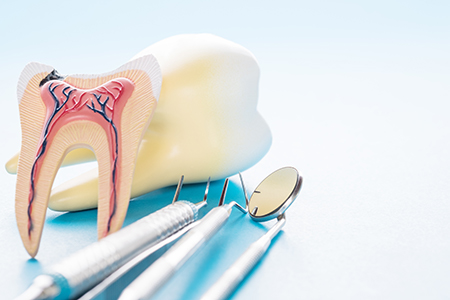
If your dentist tells you a tooth needs root canal treatment, there’s no reason to panic. Modern root canal therapy is a precise, routine procedure designed to remove infection and protect the structure of a tooth—often with the same level of comfort you’d expect from a standard dental restoration. The goal is to relieve pain, eliminate infection, and preserve your natural smile whenever possible.
At the office of Saugeen Shores Family Dentistry, we combine careful assessment with up-to-date techniques to deliver gentle, effective care. Patient comfort and predictable outcomes guide every step of treatment, so you can feel confident that your oral health is being handled with skill and respect.
Keeping a natural tooth in place, when feasible, offers clear advantages for chewing, speech, and facial balance. A tooth that has been restored after root canal therapy continues to support the surrounding teeth and bone, reducing the likelihood of shifting or uneven wear that can complicate future care.
Root canal treatment focuses on removing diseased tissue from inside the tooth and sealing it to prevent reinfection. When combined with a well-fitting restoration, such as a crown, this approach restores function and helps the tooth remain stable for years — often a lifetime with proper maintenance.
Choosing to preserve a tooth also avoids the additional procedures that come with replacing a lost tooth, such as bridges or implants. Preserving your own tooth keeps treatment focused and conservative, supporting both oral health and long-term comfort.

Inside each tooth lies the dental pulp — a small but vital bundle of nerves, blood vessels, and connective tissue. When bacteria reach this space because of deep decay, cracks, or trauma, the pulp can become inflamed or infected. At that point, root canal therapy is often the best way to remove the source of infection and protect the tooth.
Symptoms that suggest the pulp is compromised vary. Some patients experience sharp or persistent pain, while others notice heightened temperature sensitivity or an ongoing ache when biting. In other cases, changes like darkening of a tooth or swelling of the gums are the first signs that an internal problem has developed.
Not every toothache requires a root canal, and some teeth with extensive internal changes may show no obvious symptoms at all. A thorough clinical exam, including imaging when needed, helps determine whether root canal therapy or another intervention is the appropriate next step.
If you notice any of the following signs, prompt evaluation is important:
Prolonged or intense tooth pain, especially pain that disrupts sleep or remains after initial treatments, is a common indicator of deep tooth involvement. Persistent discomfort is a signal that an internal infection may be present.
Mild, brief sensitivity is normal for many people; however, sharp or lingering pain when consuming hot or cold foods can point to inflamed pulp tissue that should be assessed promptly.
Pain on biting or tenderness to gentle pressure may mean the pulp is involved or that an infection has affected the tissues around the root of the tooth.
A tooth that has changed color may have lost vitality due to prior injury or internal changes. Discoloration can be a clue that root canal assessment is warranted.
Damage to the outer shell of a tooth can expose inner tissues to bacteria. When structural compromise allows bacteria to reach the pulp, root canal therapy may be needed to save the tooth.
Swollen gums, a persistent pimple-like bump on the gum, or drainage near a tooth can indicate an abscess. These signs require timely professional attention to prevent spread of infection.
Infection that reaches the supporting bone can cause a tooth to feel loose. Root canal therapy, combined with appropriate restorative care, can allow the tissues to heal and help stabilize the tooth.

Prompt diagnosis and treatment of an infected tooth reduce the risk of complications that can affect surrounding teeth and tissues. An infection confined to a single tooth is generally easier to treat than one that has spread into the jawbone or soft tissues.
Waiting to treat a tooth can allow the infection to advance, leading to larger areas of inflammation, more extensive restorative needs, and a greater chance that extraction may become necessary. Early intervention helps preserve more of the natural tooth and simplifies restorative planning.
Our team emphasizes careful monitoring during routine exams and encourages patients to report new symptoms early. When a problem is caught in its early stages, treatment is typically faster, less complex, and more comfortable.
Today’s root canal procedures use refined instruments and techniques to remove infected tissue, disinfect the internal spaces of the tooth, and seal the canals to prevent reinfection. Most treatments are performed under local anesthesia so that patients remain comfortable throughout the appointment.
The length of treatment depends on the tooth’s anatomy and the presence of infection. Some teeth can be treated in a single visit; others benefit from a staged approach that allows time for the infection to respond before final sealing. Your dentist will recommend the plan that best fits the clinical situation.
After the canals are cleaned and sealed, the tooth typically receives a permanent restoration — often a crown — to restore strength and function. A well-fitted restoration protects the treated tooth from fracture and helps ensure long-term success.

Following root canal therapy, many patients notice immediate relief from the worst of their pain, though mild soreness or tenderness around the treated tooth is common for a few days. This response is part of the normal healing process as surrounding tissues settle.
Protecting the treated tooth until the permanent restoration is placed is important. Temporary materials provide short-term protection but do not restore full strength. Avoid chewing hard or sticky foods on the treated side, and follow any specific instructions your dental team provides.
Continuing good daily oral hygiene and attending follow-up visits help support healing and maintain the long-term health of a treated tooth. With appropriate restorative care and regular dental checkups, many root canal-treated teeth remain functional for decades.
Aftercare tips you can expect from your dentist include:
Numbness from local anesthesia can last for an hour or two. Take care not to bite your lips or tongue until normal sensation returns to avoid accidental injury.
Mild to moderate discomfort can occur as the mouth heals. Over-the-counter pain relievers are often sufficient; your dentist will advise on appropriate options and prescribe medication if clinically indicated.
If antibiotics are prescribed to address or prevent infection, it’s important to complete the full course exactly as directed to support healing.
Temporarily restored teeth are more vulnerable to fracture. Try to chew on the opposite side and avoid foods that could dislodge a temporary filling.
Brushing and flossing around the treated tooth help reduce plaque and support the healing process, preventing future problems that could compromise the restoration.
Replacing the temporary filling with a durable crown or other suitable restoration restores strength and reduces the risk of fracture or reinfection.
When performed and followed by appropriate restoration and regular monitoring, root canal therapy offers a reliable path to relieve pain and preserve a natural tooth. The office of Saugeen Shores Family Dentistry is dedicated to delivering careful, evidence-based care designed to protect your oral health.
If you’d like to learn more about root canal treatment or think you may need an evaluation, please contact us for more information.
A root canal procedure is the best way to save a tooth that has been damaged by decay or injury and preserve your natural smile. The alternative is an extraction and treatment to replace the tooth. While at times a tooth is non-restorable and an extraction is the only option, when possible, it’s best to try and save your natural tooth. With proper care, a tooth with root canal therapy can serve your smile well for many years to come.
Despite lingering myths from before the age of modern dental anesthesia and technology, having a root canal procedure today is as routine and comfortable as visiting the dentist for a filling. While the procedure is performed under local anesthesia with your tooth completely numbed, we can also discuss options in dental sedation.
Whether the symptoms of a dental infection subside after a course of antibiotics, a draining abscess provides you with some temporary pain relief, or a tooth with radiographic evidence of pathology has not yet developed symptoms, it’s essential, before an infection worsens or occurs, to have a root canal procedure performed. In this way, the tooth can be disinfected, filled, and sealed to protect your health and avoid further problems.
If you have sustained a dental injury, have a toothache, jaw pain, swelling, or are experiencing any other unusual and uncomfortable oral symptoms, contact our office immediately for care. Dental problems that have not been evaluated and treated can significantly worsen, producing more severe damage and consequences for the involved teeth, your oral health, and even your overall wellbeing. Once you get in touch with our office, our friendly and compassionate office team will get you in for care at your earliest convenience.
While some root canal procedures can be completed in one visit, others may involve 2 or 3 appointments. How long it takes depends on various factors, including active infection, the number of canals in the tooth, and the tooth’s location or anatomy.
With a success rate that exceeds 95%, root canal therapy remains the most effective procedure to save a tooth in which the inner vital tissues have been damaged. However, as with all healthcare procedures, there are a small percentage of cases where the teeth become symptomatic a second time. The good news is that many of these teeth can still be saved with root canal retreatment or a minor surgical procedure known as an apicoectomy.
The best ways to maintain a tooth with root canal therapy are to get the proper restoration required to rebuild and protect the tooth, maintain proper oral hygiene, and schedule appointments for routine dental checkups and care.
Saving a tooth with root canal therapy is a wise investment that, in the long run, is typically less costly and invasive than having the tooth extracted and replaced with a fixed bridge or implant. As far as the exact cost of care, it can vary depending on which tooth is being treated. Many dental insurance plans provide coverage for root canal therapy. At the office of Saugeen Shores Family Dentistry, we do our best to optimize your dental benefits and minimize your out-of-pocket expenses. Our staff will answer all your questions about the cost of care and discuss all your payment options.
At the office of Saugeen Shores Family Dentistry, we use the latest technology and most effective methods of care to provide precise and gentle care. Our reputation for excellence is based upon a consistent record of achieving successful treatment outcomes while providing prompt, stress-free, and convenient treatment for every type of dental need.
A root canal is a dental procedure that removes infected or damaged pulp from inside a tooth to preserve the remaining tooth structure and relieve pain. The goal is to clean, disinfect and seal the tooth’s internal canals so the tooth can remain functional in the mouth. Root canal therapy is recommended when the dental pulp is irreversibly inflamed, infected or necrotic due to deep decay, trauma or repeated dental work.
Timely treatment helps prevent the spread of infection to surrounding tissues and preserves the natural tooth, which supports chewing function and jawbone health. In many cases a root canal is followed by a permanent restoration such as a crown to protect the treated tooth from fracture. Early diagnosis through clinical exam and radiographs allows a dentist to determine whether root canal therapy is the best option.
A tooth usually needs root canal therapy when the inner pulp becomes inflamed or infected, most often because of deep decay that reaches the pulp chamber. Trauma, cracks, repeated restorative procedures and untreated cavities can also expose or damage the pulp and create conditions that lead to infection. Bacteria that reach the pulp produce inflammation and may cause an abscess at the root tip if left untreated.
Once the pulp is irreversibly compromised, the body’s natural healing responses are insufficient and the infection can progress into surrounding bone and tissue. Radiographic evidence of periapical changes or the presence of an abscess often accompanies the diagnosis. Addressing the problem with root canal therapy removes the source of infection and protects adjacent teeth and supporting bone.
Common signs include persistent toothache, especially pain that wakes you at night, prolonged sensitivity to hot or cold, and discomfort when biting or chewing. Other indications are visible darkening of a tooth, swelling or tenderness of the nearby gums, and the presence of a draining bump or abscess on the gum. Some teeth with pulp damage show minimal or no symptoms and are identified on routine radiographs or exams.
Because symptoms can overlap with other dental problems, a clinical evaluation and appropriate X-rays are necessary to confirm the need for root canal therapy. Early assessment limits the risk of the infection spreading and improves the chances of saving the tooth. If you notice any of these signs, prompt evaluation by a dentist is recommended.
A root canal procedure begins with local anesthesia to ensure the tooth and surrounding tissues are numb, and a rubber dam is often placed to isolate the tooth and keep the area dry. The dentist then creates a small access opening in the crown, removes the diseased pulp from the canal system, and carefully cleans and shapes the canals using specialized instruments and irrigation solutions. Once the canals are disinfected, they are filled with a biocompatible material and sealed to prevent reinfection.
Depending on the tooth’s anatomy and the presence of infection, treatment may be completed in one visit or over two or more appointments. After root canal therapy the tooth typically requires a permanent restoration, such as a crown, to restore strength and function. Modern techniques and instruments make the treatment predictable and focused on preserving natural tooth structure.
With modern anesthesia and techniques, most patients experience little to no pain during the procedure itself; local anesthesia numbs the area and keeps the treatment comfortable. Some mild soreness or tenderness is common for a few days as surrounding tissues heal, and this is usually manageable with over-the-counter anti-inflammatory medications as recommended by your dentist. More significant discomfort is uncommon and often related to preexisting infection or complex anatomy.
If antibiotics or prescription pain medications are indicated, your dentist will provide clear instructions and follow-up care. Persistent or worsening pain, swelling or other concerning symptoms should be reported promptly so the dentist can reassess and provide appropriate care. The overall aim of root canal therapy is to eliminate the source of tooth pain and restore comfort and function.
After a root canal, follow the dentist’s instructions for medications, oral hygiene and eating to support healing and prevent complications. Avoid chewing on the treated tooth until a permanent restoration is placed, and choose soft foods if the area feels tender; maintain regular brushing and gentle flossing to keep surrounding teeth and gums healthy. If a temporary filling or crown is in place, take care to avoid hard, sticky or crunchy foods that could dislodge the temporary restoration.
Attend any recommended follow-up visits so the dentist can confirm healing and complete the final restoration when appropriate. Timely placement of a permanent crown or suitable restoration protects the tooth from fracture and restores full function. If you experience unusual symptoms such as increased pain, swelling or drainage, contact your dental office for prompt evaluation.
A properly treated and restored tooth can last many years and often a lifetime with good oral hygiene and regular dental care. Success depends on factors such as the tooth’s anatomy, the presence of preexisting infection, how well the canals are cleaned and sealed, and the quality and timeliness of the final restoration. Teeth that receive a protective crown after root canal therapy are less likely to fracture and tend to have better long-term outcomes.
Regular dental checkups and radiographs help monitor the treated tooth and surrounding tissues so any issues are identified early. Maintaining routine preventive care, including cleanings and exams, supports the longevity of the restoration and overall oral health. If new symptoms develop around a previously treated tooth, contact the dentist for assessment and possible retreatment or additional care.
The main alternative to root canal therapy is tooth extraction, which removes the infected or damaged tooth entirely. Extraction eliminates the source of infection but creates considerations for replacing the missing tooth to restore chewing function, maintain occlusion and prevent shifting of adjacent teeth. Depending on the tooth’s condition, root canal therapy is often recommended because it preserves the natural tooth and maintains dental and jaw structure.
A dentist will evaluate the tooth, review radiographs and discuss the advantages and limitations of each option, including the long-term implications for oral health. In some cases, endodontic retreatment or referral to an endodontist may be recommended if previous treatment has failed. The decision should be based on clinical findings, restoration prospects and the patient’s overall dental goals.
Yes, children and teenagers can receive root canal treatment when the pulp of a permanent tooth is irreversibly damaged or infected. For immature permanent teeth, procedures such as apexification or regenerative endodontic techniques may be considered to encourage root development and preserve tooth structure. Primary (baby) teeth are treated differently; when the pulp is involved in a primary tooth, a pulpotomy or extraction may be chosen depending on the child’s age and the tooth’s role in guiding permanent tooth eruption.
Early evaluation after trauma or when symptoms occur helps determine the appropriate approach for young patients and preserves long-term dental health. Pediatric considerations, cooperation and behavior management strategies are part of treatment planning to ensure a safe and comfortable experience. Your dentist will explain options tailored to the child’s development and oral health needs.
Before your appointment, follow any specific instructions from the office such as taking prescribed antibiotics or arranging transportation if you will use sedation. Expect the dentist to review your medical and dental history, take necessary radiographs and explain the treatment plan and expected sequence of care; local anesthesia is typically used and sedation options are available if needed to improve comfort. Plan to allow time for the procedure and a brief recovery period, and bring a list of medications and any questions you may have.
At Saugeen Shores Family Dentistry the clinical team focuses on precise, gentle care and clear communication to help patients understand each step of treatment. After the procedure the office will provide post-treatment instructions and schedule follow-up visits to place the permanent restoration and monitor healing. If you experience persistent symptoms or have concerns after treatment, contact the practice for prompt evaluation and care.
Quick Links